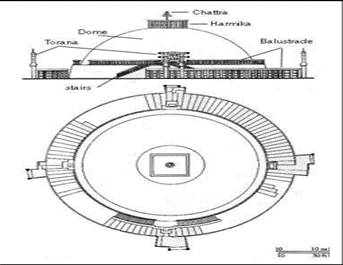History and Art and Culture
Context: In the recent excavations, the Structural Complex of the Buddhist Monastery was found in the continuation of large Stupa, Black and Red ware pottery, and Sculptures discovered from excavation done 50 years ago at the same site in West Bengal.
About Buddhist Monastery:
- A monastery is a community of men or women (monks or nuns), who have chosen to withdraw from society, forming a new community devoted to religious practice.
- The word monk comes from the Greek word monos, which means alone.
- Buddhism, the first Indian religion to require large communal and monastic spaces, inspired three types of architecture.
- Stupa, vihara and chaitya are part of Buddhist and Jaina monastic complexes but the largest number belongs to the Buddhist religion.
Significance of the excavations:

- The site was initially excavated fifty years ago between 1972 and 1975 when archaeologists from ASI found a Buddhist Stupa at the site.
- Excavations can help in finding the spread of Buddhism in the South West Bengal region.
- The discovery is also significant since black and red ware pottery from the chalcolithic age makes the village settlement on river Damodar possible.
- The complex makes the site religious while the settlement makes the site secular in nature.
- The stupa found is large compared to stupas found from other Buddhist sites in the state like Karnasubarna in Murshidabad, Moghalamari in Paschim Medinipur, and Jagjivanpur in Malda where smaller votive stupas were found.
Viharas:
- It was the ancient Indian term for a Buddhist monastery.
- Originally, viharas were dwelling places used by wandering monks during the rainy season but eventually they evolved into centers of learning and Buddhist architecture through the donations of wealthy lay Buddhists.
- Life in “Viharas” was codified early on.
- It is the object of a part of the Pali canon, the Vinaya Pitaka or “basket of monastic discipline.”
- Typical large sites such as the Ajanta Caves, Aurangabad Caves, Karli Caves, and Kanheri Caves contain several viharas.
- A rock-cut viharas at Ellora is an example of vihara.
Chaityas:
- It refers to a shrine, sanctuary, temple or prayer hall in Indian religions.
- Most early examples of chaitya that survive are Indian rock-cut architecture
- Chaityas have a gigantic hall with high vaulted roof, with a lot of sculpture work on the pillars and the entrance
- The largest Chaitya-Griha among all Buddhist monuments in India is the Karle caves.
- Many Chaityas show a stupa at the back.
- Chaityas were carved either as rectangular halls or apsidal vault-roof or apsidal vault pillarless halls.
Stupa Architecture :

- The central structure consists of a hemispherical dome on a base, with a relic chamber deep within. The dome symbolizes, among other things, the dome of heaven enclosing the earth.
- It is surmounted by a squared railing (harmika) that can be said to represent the world mountain.
Source: The Hindu
Previous Year Questions
Q.1) With reference to Indian history, consider the following pairs:
Historical person Known as
- Aryadeva Jaina scholar
- Dignaga Buddhist scholar
- Nathamuni Vaishnava scholar
How many pairs given above are correctly matched ?
- None of the pairs
- Only one pair
- Only two pairs
- All three pairs
Q.2) Which one of the following ancient towns is well known for its elaborate system of water harvesting and management by building a series of dams and channelising water into connected reservoirs? (2021)
- Dholavira
- Kalibangan
- Rakhigarhi
- Ropar














